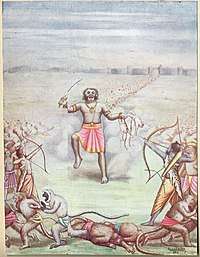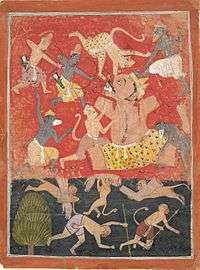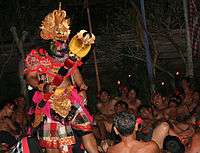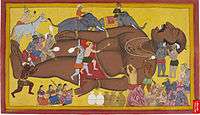Kumbhakarna
Kumbhakarna (Sanskrit: कुम्भकर्ण, lit. pot-eared) is a named rakshasa and younger brother of Ravana in the famous Hindu Legends in the events of Ramayana. Despite his gigantic size and great appetite, he was described to be of good character and great warrior in those times, though he killed and ate many monkeys only to show his power.
| Kumbhakarna | |
|---|---|
| Ramayana character | |
 Kumbhakarna yawns as he is roused from Dhyana | |
| In-universe information | |
| Species | Rakshasa |
| Family | Vishrava (father) Kaikashi (mother) Ravana, Vibhishana (brothers) Shurpanakha (sister) |
| Spouse |
|
| Children | Kumbha Nikumbha (from Vajrajwala), Bhimasura (from Karkati) |
He was considered so pious, intelligent and unchallenged warrior in battle that Indra, the king of gods, was worried and jealous of him and his strength. Along with his brothers, Ravana and Vibhishana, Kumbhkarna performed a major yajna and penance to please Lord Brahma. When the time came for asking a boon from Brahma, his tongue was tied by goddess Saraswati, who was acting on Indra's request; because of which, instead of asking Indraasana (seat of Indra), he asked for Nidraasana (bed for sleeping). It is also said he intended to ask for Nirdevatvam (annihilation of Devas) and instead asked for Nidravatvam (sleep). His request was granted. However, his brother Ravana asked Brahma to undo this boon as it was in reality a curse. He slept for six months and when he awoke, he ate everything in the vicinity, including humans.
Origin
In the Bhagavata Purana, Kumbhakarna is said to be the incarnation of the gatekeeper deity Vijaya. Vijaya along with his brother and fellow gatekeeper Jaya, was punished by the Four Kumaras for impiety while they guarded the sacred realm of Vishnu. Vijaya was initially sentenced to mortality, but after appealing to the deity Vishnu for assistance, Vishnu agreed to reduce their sentence to just three lifetimes as his enemies before allowing them to return to the sacred realm Vaikuntha (place of eternal bliss). While his brother Jaya became Ravana, Vijaya became the godly demon Kumbhakarna during their second incarnation of three on Earth.
War




During the war, Ravana went into battle and was humiliated by Shri Rama and his army. He decided he needed the help of his brother Kumbhakarna, who was awakened with great difficulty. He woke up only after one thousand elephants walked over him (Rāmāyaṇa 6.48.47).
When he was informed of the circumstances of Ravana's war with Rama, he tried to convince Ravana that what he was doing was wrong. However, he chose to fight in the battle due to his loyalty to his brother. Kumbhakarna went into battle and devastated Rama's army. He knocked Sugriva unconscious, took him prisoner, but was ultimately killed by Rama. When Ravana heard of his brother's death, he fainted and proclaimed that he was truly doomed.
Kumbhakarna had two sons, Kumbha and Nikumbha, from his wife Vajrajwala, the daughter of Bali and granddaughter of Virochan who too fought in the war against Rama and were killed. He had another son named Bhimasura from another wife Karkati who was the princess of sayadri. Later when she heard about her husband's death, rather than to take avenge from Rama, she ordered her son to perform harsh penance of Brahma and take a boon to remain invincible. But Bhimasura was later killed by Shiva.
Characterization
Appearance
Kumbharana is depicted in various Indian Aam Lal pal Hal chal paintings.[2][3] He is portrayed as a giant, sometimes with horns.
Personality
Kumbhakarana is portrayed as a virtuous character, despite his monstrous size and appearance. He had asked his older brother Ravana to apologize for kidnapping Sita, however, Ravana did not heed this advice.
He used to sleep for 6 months at a time.
See also
Notes
- Barwani - Census of India (PDF)
- "The Demon Kumbhakarna Is Defeated by Rama and Lakshmana: Folio from a Dispersed Ramayana Series". Metropolitan Museum of Art. Retrieved 25 October 2019.
- Wight, Colin. "Ramayana: Pages 51 and 52". www.bl.uk. Retrieved 25 October 2019.
External links
| Wikimedia Commons has media related to Kumbhakarna. |
- Sri Lanka, Virtual Library. KUMBHAKARNA
- Pot-Ear's Awakening. From the Ramayana, as translated by Arthur W. Ryder
.jpg)
